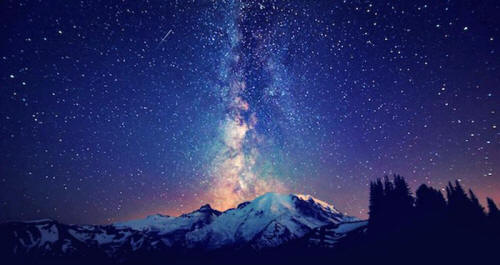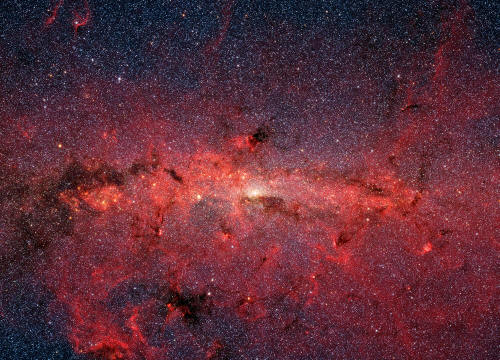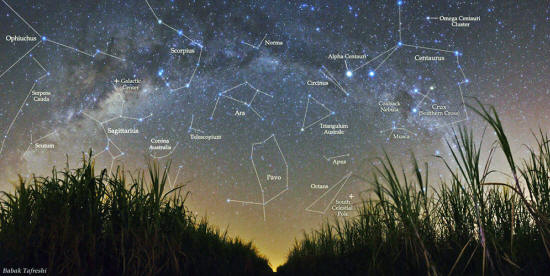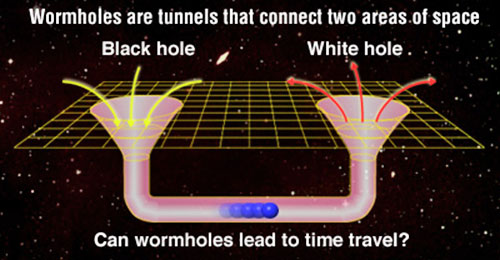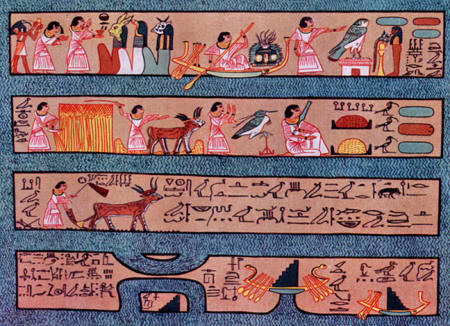|
|
|
by Bibhu Dev Misra
from
BibhuDev Website
A few accounts try to explain how the Milky Way came to appear as a faint band of milky-white glow arching across the night sky, while some others are more mysterious. They talk of the presence of a "Spirit Trail" or a "Road of Souls" in our galaxy, along which the souls of dead people travel to a mystical underworld.
Many ancient cultures subscribed to such
beliefs, but the true meanings and origins of these cosmic tales
remain a mystery.
The Spirit Trail to
the Otherworld
For instance,
The overarching idea seems to be that
the Milky Way is the White Road traversed by the gods.
Amongst the American Indian tribes, the Milky Way is known by various names:
According to the Apache Indians of Southwestern America, the souls of the dead travel along this "Spirit Trail" for four days, before they reach a place of peace and plenty where there is no disease or death.4
The Lakota Indians, who live in the Great Plains of North America, believe that the spirit, on its journey to the otherworld, must pass by an old woman who inspects their spirit bodies for the proper markings.
Only if they possess the correct markings, are they allowed into the peace and plenty of the otherworld, the land of many lodges, where all one’s ancestors pitched their tipis and buffalo roamed in unending abundance.5
The Pueblo Indians of Southwestern America share the belief that the deceased returns to the underworld through an entrance.
Underworld is not only the place from
which the race emerged and the place to which its individuals
return, but it is as well the storehouse of all life-giving crops
which are in season drawn up to nourish the living.6
This "Spirit Trail" or the "Road of Souls" leads from our galaxy to a mystical underworld of unknown location, where the ancestors live in perpetual peace and happiness.
The Quiche Maya of the highlands of Guatemala actually have a very specific location for this pathway to the otherworld, which indicates that there is a physical reality underlying these intriguing beliefs.
They point to the region of the Galactic Center as being the location of Xibalba Be - the dark road that leads to the underworld.
For someone living in the Northern Hemisphere, it will be difficult to identify the Galactic Center with the naked eye, since the Milky Way appears as an extremely faint band of milky-white glow arching across the night sky.
The Galactic Center lies low in the southern sky during the summer months in the Northern Hemisphere, and is hard to locate precisely.
This dazzling infrared image from NASA's Spitzer Space Telescope shows hundreds of thousands of stars crowded into the Swirling Core of our spiral Milky Way galaxy. In visible-light pictures, this region cannot be seen at all because dust lying between Earth and the galactic center blocks our view.
However, in the Southern Hemisphere, the skies are very dark, and the light pollution is much lower. On a moonless night, away from the city lights, the Milky Way comes into prominent view.
Even a small binocular can resolve this
band of light into thousands of stars.
The Galactic Center is located at the center of a dense bulge of stars (the central bulge), and its exact position lies in the direction of the Sagittarius constellation.
It is here that the Quiche Mayans
believe, is present, a "sky cleft" or a "hole in the sky", from
where a dark road leads to the underworld.
This image of the night sky in the Southern Hemisphere shows the Milky Way band, along with the constellations. The Galactic Center is identified by the Sagittarius constellation.
Source: NASA APOD
2009 May 9.
According to Roberta and Peter Markmann,
The entrance to the underworld was also depicted in certain Classic Period Maya art as the "mouth of a water monster"; while in certain Late Postclassic Central Mexican art, the entrance is represented as a cave.
Both deities and human ancestors are
born out of this cave, and after death they enter into this cave and
descend to the underworld.
And as per the Quiche Maya, this sky-cleft was present near the Galactic Center, in the direction of the Sagittarius constellation.
Is it a mere coincidence that
astronomers have recently discovered that a
supermassive black hole is present
at the center of the Milky Way galaxy, in exactly the same region
where the Mayans believe is present a hole in the sky that leads to
the underworld?
Journey through a
Black Hole
Further studies since then have shown
that this black hole is nearly 4.3 million times the mass of the
sun, and is squeezed into a tiny space, which is only ten times
bigger than the sun and is slightly less than the orbital distance
of Mercury from the Sun (i.e. 46 million kilometers).
The black hole, however, still retains its original mass, and thereby attracts nearby objects.
Its gravitational pull is so intense that nothing, not even light, can escape from it once it falls within the boundary of the black hole called the event horizon. Since a black hole does not emit any light, it is very difficult to see it, especially if it floats alone in space.
However, if a black hole passes through a cloud of interstellar matter, it can accrete matter into itself by its gravitational attraction.
Thus, a black hole will be surrounded by superheated rings of hot gas, dust and stars which rotate around it at extremely high speeds, spiraling towards the event horizon. This ring of gas, dust and stars around a black hole is called the accretion disk, which contains the event horizon at its center.
The accretion disk is a prolific source
of radiation at all frequencies - from radio waves to visible light
to X-ray light. Fig 2 A supermassive black hole at the core of a galaxy blasting out radiation and ultra-fast winds.
Credit:
NASA/JPL-Caltech
Were the Mayans aware of the existence of this black hole, thousands of years before it was discovered by modern scientists?
Their usage of the term "mouth of a water monster" to refer to this sky-cleft is very pertinent. A black hole does appear like a cosmic mouth which violently consumes anything in its vicinity.
Some of the material swirling into the
black hole does not fall in but rather is spit out at incredibly
fast speeds, close to the speed of light. Scientists sometimes
compare this to a messy eater who is trying to eat too much food at
once and has food falling from his mouth.9
Einstein and Rosen had put forward a theory that there may be a bridge or a passage which connects a black hole to a white hole, existing in different parts of the universe.
A white hole is just the reverse of a black hole. Just as a black hole swallows things irretrievably, so a white hole spits them out. This bridge connecting a black hole - white hole pair came to be known as the Einstein-Rosen Bridge and was subsequently simply referred to as a wormhole.
Scientists have speculated that a spaceship may be able to enter a black hole, travel through a wormhole, and emerge through a white hole in another part of the universe, travelling faster than the speed of light.
Stephen Hawking once quipped:
In the Einstein-Rosen theory, however, the idea of objects larger than electrons being able to pass through a wormhole was not considered, since the tremendous gravitational pressure existing inside a black hole is likely to disintegrate everything into the most fundamental particles.
The atoms will get ripped apart, and even the nuclei would get stretched and elongated. However, if the black hole is spinning, its opening may remain stable, and it may be possible for an object to enter a black hole.
This theory was proposed in 1962, by the New Zealand mathematician Roy Kerr.
Accordingly, rotating black holes with stable gateways are known as Kerr black holes. It has now been found that all the black holes discovered till date are rotating very rapidly, some as fast as a million miles per hour.
Kerr black holes, therefore, may be the most realistic and abundant form of black holes in the universe!
There are doubts, still, regarding how stable the black hole entrance is, and how safe it may be to travel through the wormhole. Physicists argue that the very presence of an object, even light, will destabilize the wormhole, and it will collapse and evaporate before anything passes through it. 11
In order to send something through a
wormhole, there would need to be some kind of scaffolding made from
"exotic matter" to hold the wormhole open.
Fig 3 This diagram shows a wormhole connecting a black hole and a white hole.
Source:
http://www.angelfire.com/moon/astronomy/wormholes.html
Professor Paulo Salucci said that,
Other spiral galaxies like the Milky Way may also contain wormholes at their cores.
In their paper, the scientists wrote:
It is interesting that current scientific thought regarding black holes and wormhole travel is very similar to the Mayan cosmic conception that a dark road leads from the sky-cleft at the Galactic Center to a mystical underworld.
There is a definite correlation here, which simply cannot be ignored. Although the possibility of travel through a black hole is still subject to debate, we should remember that as per the ancient traditions of the Americas, it is not a spaceship which journeys through this hole in the sky.
Rather, it is the soul of a dead person
which takes this route to the underworld. The soul being an entity
not yet understood by modern science, its effect on the stability of
the black hole gateway cannot be ascertained as yet.
The ancient Indians possessed a similar kind of understanding as well.
In a few passages of the Indian
spiritual poem,
the Bhagavad Gita, one can find
vivid descriptions of what could be a black hole sucking in the
souls of dead warriors.
The Flaming Mouths of
Krishna
Arjuna, in spite of being a formidable warrior, had become reluctant to take part in this battle against his old friends and relatives for defending the rightful claim of his elder brother to the kingdom of the Kurus.
In order to rouse his spirits and dispel his confusion, Krishna then launched into an extensive sermon of the subject of duty and dharma, laying particular stress on the principles of selfless action and non-attachment to results.
At a certain point during this
philosophical and spiritual discourse, Krishna, who has been
uniformly regarded in the Indian tradition as a mortal incarnation
of the Creator Vishnu, displays his "universal form" to Arjuna.
Since this form cannot be seen with the naked eyes, Krishna grants
the necessary "divine eyes" to Arjuna to view his cosmic form.
In the Eastern traditions there is a widespread concept of an invisible third eye being located in the middle of the forehead, between the two eyes.
The third eye is regarded as the gateway to the mystical realms and to higher states of consciousness. It is believed that the activation of the third eye produces visions, extrasensory perceptions, and mental images having deep psychological or spiritual significance for the viewer.
Traditionally, the activation of the third eye was achieved through yogic exercises and meditative practices.
However, in many shamanic cultures of Asia, Africa and America, an altered state of consciousness was produced temporarily by consuming a psychoactive substance such as psylocybin, peyote, amanita muscaria etc.
The Amazonian shamans still drink a jungle brew called ayahuasca, meaning "the Vine of the Soul".
Ayahuasca has been the subject of much research over the past few decades, and many anthropologists and enthusiasts who have partaken of this visionary plant, have been overwhelmed by its effects.
Ayahuasca transports the mind to a fantastic world of breathtaking visual tapestries, populated by colorful serpents, fearsome jaguars, and anthromorphic beings. At the same time, the brew induces feelings of love, empathy, and oneness with the universe. Some of the accounts of the ayahuasca experiences of the early explorers are very intriguing.
Anthropologist Geraldo Reichel-Dolmatoff said that, to drink yage (ayahuasca), is to return to the cosmic uterus and be reborn.13
Poet Allen Ginsberg wrote in the The Yage Letters that,
Is it possible that ayahuasca and other
psychoactive substances may, somehow, be transporting the mind
through the black hole at the Galactic Center Center to the mystical
underworld - the same place where our ancestors believed the soul
journeys after death?
At one point, he describes seeing the "blazing, flaming, all-consuming mouths of Krishna", into which the souls of the dead warriors in the battlefield rushed in, like moths rushing towards a flame.
Here are some of the relevant passages from the text:15
Since the vision seen by Arjuna was the universal form of Krishna, it is possible that the blazing, cosmic mouths of Krishna that he sees in the vision are nothing but black holes.
Just as a black hole sucks in everything due to its intense gravitational attraction, Arjuna saw all the dead warriors of the battle entering into Krishna’s flaming mouths like moths rushing towards a fire for destruction. A black hole can be extraordinarily luminescent, since it is typically surrounded by a superheated accretion disk which radiates intense light at all frequencies.
This could be why Arjuna says that the cosmic mouths of Krishna appear to him as a,
Another noteworthy aspect of these visions is that Arjuna frequently refers to Krishna’s mouths in the plural, thereby indicating the presence of many such blazing, cosmic mouths. This agrees with what we know about our universe today.
Scientists believe that a supermassive
black hole exists at the core of every galaxy in the universe.
This is exactly the kind of effect that a black hole would have on any star that it happens to gobble up.
The black hole would stretch the star due to its intense gravitational force, and practically rip it apart, such that one part of the star would go crashing inside the unknown depths of the black hole, while the other part would be emitted as matter and high-power X-ray radiation.
These brilliant, white, jets of gas and
X-ray light emitted by a black hole appears to have been described
in the text as the fearful tusks guarding the cosmic mouths of
Krishna.
There is no other cosmic entity in our universe, apart from a black hole, which can be described as a,
It appears that the sage Veda Vyasa was not indulging in mere flights of fancy by incorporating these extraordinary descriptions within the text of the Bhagavad Gita.
Instead, he was imparting to us a highly
advanced knowledge of the universe.
The Field of Hetep
In ancient Greece, people believed that a cave on the earth was the gateway to Hades, the Greek underworld (an idea that is also found in Late Postclassic Mexican art where the entrance to the underworld is represented as a cave).
One of the caves was believed to be not only larger than the rest, but pierces right through from one side to the other.
Homer probably refers to this cavity when he says,
Recently, in 2013, a group of Italian archaeologists discovered that a cave in the ancient city of Hierapolis (now Pamukkale) in southwestern Turkey was once the site of extensive rituals where priests would sacrifice bulls to the god of the underworld, Hades (known as Pluto to the Romans).
Ordinary people could watch these sacred
rites from a distance, but only the priest stood in front of the
portal.17
Pindar names Kronos as the Lord
of the underworld, and the clean and the pure are taken to his
palace where, soothing breezes off the ocean flow over the "Isle of
the Blessed", and all around flowers are blazing with a dazzling
light, some springing from the shining trees and others nourished by
the water from the sea.
This was the "Land of Osiris" and was the nearest thing to an Egyptian Elysian Fields.
Coffin Text spells and the Book of the Dead describe the Field of Hetep as a well-watered place, irrigated by channels, with abundant grain and all kinds of fruit trees, where the dead could indulge any desire, doing what they had enjoyed on earth.18
Cosmologically, the underworld was thought of as situated beneath the earth or below the western horizon.
In early times, Osiris, the Lord of the underworld, was often worshipped in a subterranean chamber, constructed below a mound or tumuli, which was reached by a winding descending passage.19
Interestingly, one of the terms associated with the otherworld was Rosetau, which literally means "passage of dragging". It initially referred to the sloping entranceway of a tomb, although it was later extended to the entire necropolis.
The term suggests that the soul of the
deceased was dragged through a descending passage to the underworld. Fig 4 The Field of Hetep depicted in the Papyrus of Ani. It shows Ani interacting with the gods, and performing activities similar to those on earth such as sailing, ploughing, reaping etc.
Source:
www.gutenberg.org
In the context of our modern scientific understanding of the cosmos, it means that after death, the soul is transported through the black hole at the Galactic Center to different realm of existence.
Needless to say, this would be quite a cosmic voyage!
To journey 26,000 light years across the Milky Way to the Galactic Center, to enter a blazing, ferocious, black hole, and then to finally arrive at a Blessed Land - this would be a journey which would undoubtedly require much courage and fortitude.
Our ancestors were aware of this long
and hazardous journey that the soul has to undertake after leaving
the material body, which is why they instituted so many elaborate
rituals and customs, (generally known as Transition Rituals), to
ensure the safe passage of the soul to the underworld. Every
religion has its own set of complicated rituals, but perhaps the
most elaborate of these were those practiced by the ancient
Egyptians.
Upon a person’s death, the ba had to embark on a perilous journey, overcoming various trials, before it could be reunited with its ka i.e. the "life force" or "vital force" which animates the ba. The union of the ba and the ka in the afterlife resulted in the formation of the akh, which is the most complete form of existence to which every Egyptian aspired.
The Egyptians believed that the dead body had to be mummified and preserved in a pristine condition, so that the ba could successfully unify with the ka in the afterlife.
The journey to the afterlife was considered as no mean feat - all manners of demons and other hazardous obstacles had to be overcome.
The funerary texts provided elaborate maps of the heavens, including the Field of Hetep and the Mansion of Osiris, along with the directions for the routes to be taken. They also contained spells and recitations to be uttered at the appropriate time. The deceased was equipped protective amulets, which were placed in the bandages surrounding the corpse.
Many personal goods and objects of daily life such as pots, tools, and weapons were also placed within the tomb, since they may be required by the soul during its journey, and possibly in the afterlife.20
Ultimately, after a long voyage, the
soul arrived at the Hall of Judgment where Osiris sat on his
throne.
Needless to say, they were extremely
concerned about the safe passage of the soul to the underworld, and
they tried to ensure that the soul received all the help that it
could get for undertaking this cosmic journey.
Did they figure this out through their cosmic voyages undertaken in deep states of meditation or in altered states of consciousness? Or could there be any merit in the stories of extraterrestrial contacts, which is mentioned in countless legends from around the world?
Whatever be the method, the correlations between these ancient beliefs and our modern scientific understanding of the cosmos are quite remarkable.
Of course, there is much we do not understand. It is not clear, for instance, how the soul undertakes the immense across the galaxy to the black hole, or where the wormhole which originates from the black hole leads. But, our ancestors have left behind a plethora of cryptic symbols and mysterious legends, whose real meanings still remain undeciphered.
Perhaps the answers to the questions confronting us lie encoded in this legacy of intriguing artifacts and doctrines?
As we probe the furthest reaches of the
universe with our telescopes and satellites, it may be the right
time to take a fresh look at the cosmic wisdom of the ancients.
|


